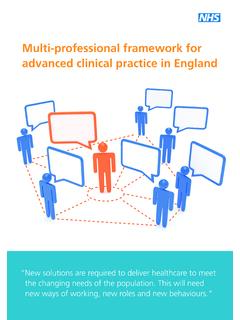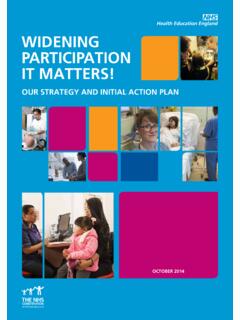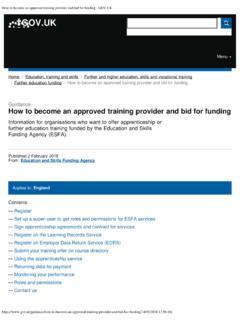Transcription of The future pharmacy workforce - Health Education England
1 The future pharmacy workforceThe vision for the pharmacy workforce in the context of the NHS Long Term PlanInformed by the HEE Advancing pharmacy Education and training (APET) ReviewFocus of the presentationThe NHS Long Term Planvision for pharmacyThe HEE Advancing pharmacy Education and training (APET) Review Current issues, recommendations and major developmentsInitial Education and training of pharmacy techniciansEarly career (post-registration) pharmacy technician trainingInitial Education and training of pharmacistsEarly career (post-registration) pharmacist trainingPost-foundation and advanced clinical practiceConsultant practiceTechnical servicesThe vision for the pharmacy workforce To have a robust plan to deliver the LTP through a pharmacy workforce , providing high quality, patient-focused medicines optimisation across all sectors, including primary care networks and support to urgent care treatment centres, and to reduce preventable illness and identify people with high-risk conditions.
2 To work with partners to ensure the initial Education and training of pharmacists and pharmacy technicians creates the right workforce in the right place, through modern Education and funding models. By working through the new Education Governance Oversight Board, including the Royal Pharmaceutical Society, GPhC, employers, learners, universities and Education providers, to: odeliver a cross-sector foundation programme. osupport the development of pharmacy professionals beyond early years foundation level training , to create routes to progress to higher levels of practice, including clinical pharmacy technicians, advanced clinical practitioner and consultant pharmacist status and to senior organisation and system leadership vision for the pharmacy workforce (continued) Ensure that all training for all pharmacy professionals is performed to robust standards with appropriate training pathways that underpin the roles of the whole pharmacy team. Deliver best value and patient outcomes from approximately billon annual medicines expenditure by developing leadership capacity and capability and a local head of profession for each ICS in the form of Clinical Directors of pharmacy and Medicines Optimisation.
3 Build engagement, consensus and support for the changes in Education and training being developed to support the LTP by working with stakeholders and through successful national and regional vision for the pharmacy workforce (continued) Enable ICS senior managers and the new Clinical Directors of pharmacy and Medicines Optimisation to develop their local pharmacy teams to deliver the LTP need through national and local management of workforce demand and supply, using meaningful and reliable data, reducing geographical variation in supply, vacancies and improved recruitment and retention. Attract more, and a wider pool of, people to the pharmacy professions by improving the image and reputation of the pharmacy professions, raising the profile of new and valued roles for pharmacy in supporting NHS patients. Achieve a consistent and high-quality approach to modern pharmacy practice through our combined pharmacy Education and training review The NHS Long term plan presents new opportunities for pharmacy professionals to work with patients and, within a multi-professional team environment, widen their contribution to frontline care and make the most of their clinical skills, including, but also beyond, medicines optimisation.
4 To help ensure the success of these initiatives for patients, the NHS pharmacy workforce will need to continue to meet the highest professional standards, underpinned by a rigorous, more clinically-focused, career-long framework of training and Education . This requirement led NHS England , NHS Improvement and Health Education England to commission a review of pharmacy Education and training . The pharmacy deans at Health Education England have worked together, with the policy team, to reflect on the current arrangements for pharmacy training and Education and consider the levers for change. Recommendations have been made, based on an analysis of existing evidence and reflecting best practice across the career Education and training of pharmacy techniciansKey issues, challenges and interdependencies Supply of pharmacy technicians as the GPhCregister numbers are static. Impact of the new initial Education and training (IET) standards on the current workforce . Ensuring educational infrastructure and training quality.
5 The impact of the new apprenticeships, the apprenticeship levy and Government targets for apprentices. Need to develop cross-sector experiences. HEE Talent for Care strategy and widening participation. Rebalancing medicines legislation and pharmacy Education and training of pharmacy techniciansRecommendations1. Work with NHS England Improvement to support the growth of the workforce to meet servicedemands through: undertaking a workforce intelligence study to understand the changing landscape of the pharmacy technicians workforce ; supporting employers in accessing the pharmacy technician apprenticeship scheme; supporting growth of the workforce and meeting demand by increasing the number of pre-registration trainee pharmacy technicians in Work with partners to increase the quality of the learning environment through existing educational infrastructures. 3. Identify how the new qualification could be used to support growth of a pharmacy technician workforce educated in primary care, with cross-sector learning experiencInitial Education and training of pharmacy techniciansCurrent major developments A new single qualification, ready to launch in February 2020.
6 New Level 3 apprenticeship remains in development. Local work with workplaces and employers to enable them to deliver the new qualification and new elements, such as accuracy checking and medicines reconciliation. Emerging cross-sector pilots across the country linking hospital, community and general practice pharmacy technician career (post-registration) pharmacy technician trainingKey issues, challenges and interdependencies Much of the current workforce needs access to further training to meet these changes and demands. Many new roles are developing in the NHS, including:oclinical pharmacy technicians in hospitals and general practice;omedicines administration roles in hospitals;ocare home and primary care roles;oHealthy Living pharmacy leadership. Existing medicines management frameworks, which are now co-ordinated by APTUK, which need to track these career (post-registration) pharmacy technician trainingRecommendationsRecommendations1. 2. 1. Work with partners to explore future opportunities for pharmacy technicians to practise in order to advancetheireducation and training , enabling them to contribute to future service development and workforce capacity, within all HEE workforce plans.
7 2. Work with professional organisations to ensure entry into the profession requires the use of professional development frameworks and incorporates educational and clinical supervision for individuals on the development Develop multiprofessional clinical syllabi, to include clinical pharmacy technicians requirements, alongside other Following the introduction of the new IET qualification, work with employers and professional bodies to ensure that the legacy workforce and newly qualified pharmacy technicians complete a post-registration programme to attain competence in a range of key medicines optimisation activities. Early career (post-registration) pharmacy technician trainingCurrent major developments Commence role analysis of pharmacy technicians with APTUK, funded by PhIF, to develop new career professional framework, including a clinical pharmacy syllabus. Local and regional support for post-registration development, via HEE Schools of pharmacy and Medicines Optimisation and HEE pharmacy Teams.
8 Access to a wide range of learning resources, via HEE funded CPPE. Ongoing access for community pharmacy technicians to NHS Leadership Academy Programme Mary Seacole , via CPPE, through PhIF funding. Ongoing access for community pharmacy technicians to Accuracy Checking Qualification, via PhIF Education and training of pharmacists Key issues, challenges and interdependencies Patients and service require a pharmacist to be clinically focused earlier in the career pathway. Changing world of Higher Education (Augur Review). Experiencing a lower number of applications into the MPharmdegree. Exposure to practice and involvement of the NHS in MPharmprogrammes remains limited. Increasing number of places for pre-registration pharmacist training , are being submitted through the HEE national recruitment scheme (Oriel). Recent GPhC consultation on initial educationand training (IET) standards. Early work on a pharmacist Education and training of pharmacists with the GPhCto explore future options to develop and test integrated models of initial Education and training (IET) for pharmacists, following the outcome of the GPhC sconsultation.
9 Review HEE funded pre-registration pharmacist training programmesas part of this Work with NHS England and NHS Improvement to review the commissioning arrangements for pre-registration pharmacists and develop a reformed funding model that is responsive to regulatory reform and service needs. with employers, Education providers, professional and regulatory bodies to ensure trainee pharmacists are clinically competent at the point of registration and beyond and are equipped with the appropriate soft and hard skills to meet the objectives of the Long-term plan and the NHS. with employers, Education providers, professional and regulatory bodies to enable the HEE quality framework to be applied across pharmacy practice settings, providing a clinical learning environment 5. Continue to roll out robust quality Education and training of pharmacistsCurrent major developments Modernising pharmacy Careers (MPC) Workstream 1oEvidence base for contextualising learning early in professional development Multisector training , including general practice, funded by pharmacy Integration Fund and HEE, for 19/20 and 20/21 intakesoBuilding partnerships locally National recruitment scheme (Oriel) seeing increasing number of places oDeveloping collaboration across pharmacy workforce nationally Application of the HEE Quality Framework in work placesoDevelops expectations across healthcare professions workforce demand and supply modelling are being exploredEarly career (foundation) pharmacist training Key issues, challenges and interdependencies Don t have national agreed standards and outcomes to assure patient safety.
10 Current model will not meet demand nor meet changing work locations and practices. Keep up with changes in the MPharm. Need to join up career development stages at pre-registration and advanced and advanced clinical practice stage. Provide the key features of high quality training for all. Adequately resource for training for a significant number of clinical pharmacists. Drive vocational learning and facilitate multidisciplinary learning and Work with employers, Education providers, professional and regulatory bodies to develop and design a national vocational foundation training programme for pharmacists. This would initially be based on the principles set out in the body of this review, will build on the GPhCconsultation and review of initial Education and training , and be phased accordingly. 2. Create an England -wide working group to develop an implementation plan for piloting and testing the national vocational foundation training programme for pharmacists. Ensure close working with UK Health Education colleagues to ensure UK Work with NHS England and NHS Improvement to create a sustainable funding model for foundation pharmacist career (foundation) pharmacist trainingRecommendations Early career (foundation) pharmacist training Principles Principle 1: a national training programme aligned to a national curriculum (ideally UK), with a career framework, including syllabus, as well as an assessment strategy and a national certificate of completion.









![Midlands [1 of 2] - hee.nhs.uk](/cache/preview/6/c/1/4/2/e/2/7/thumb-6c142e2790d053a442bd8a3e81c79697.jpg)







